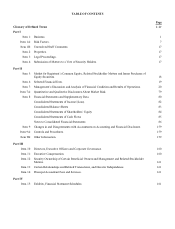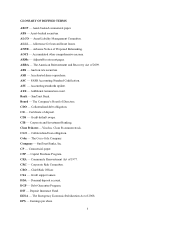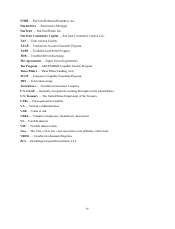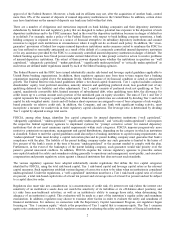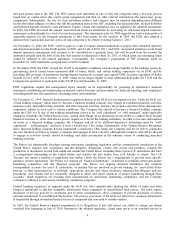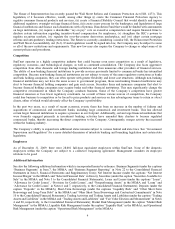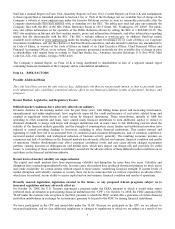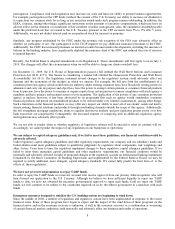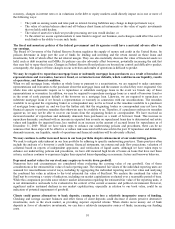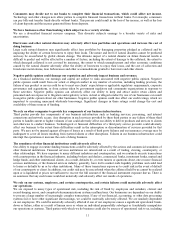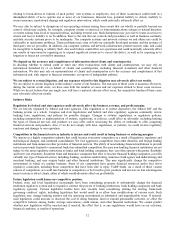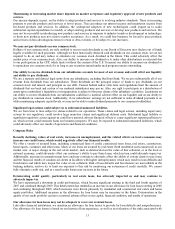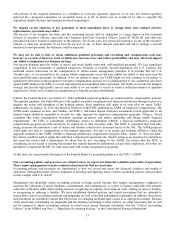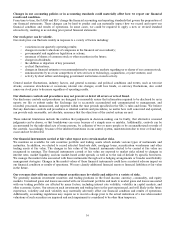SunTrust 2009 Annual Report Download - page 22
Download and view the complete annual report
Please find page 22 of the 2009 SunTrust annual report below. You can navigate through the pages in the report by either clicking on the pages listed below, or by using the keyword search tool below to find specific information within the annual report.The House of Representatives has recently passed the Wall Street Reform and Consumer Protection Act (H.R. 4173). This
legislation, if it becomes effective, would, among other things (i) create the Consumer Financial Protection Agency to
regulate consumer financial products and services, (ii) create a Financial Stability Council that would identify and impose
additional regulatory oversight on large financial firms, (iii) create a new process for the bankruptcy and liquidation of large
financial institutions and finance such dissolutions with a Systemic Dissolution Fund that would be funded with assessments
on large institutions, (iv) require a shareholder “say on pay” vote on executive compensation and require financial firms to
disclose certain information regarding incentive-based compensation for employees, (v) strengthen the SEC’s powers to
regulate securities markets, (vi) regulate the over-the-counter derivatives marketplace, and (vii) adopt certain mortgage
reforms and anti-predatory lending restrictions. The Senate is currently considering a similar bill, the Homeowner Protection
and Wall Street Accountability Act (S-3). If such legislation would be signed into law, the Company may be subject to some
or all of the new restrictions and requirements. This new law may also require the Company to change or adapt some of its
current policies and procedures.
Competition
SunTrust operates in a highly competitive industry that could become even more competitive as a result of legislative,
regulatory, economic, and technological changes, as well as continued consolidation. The Company also faces aggressive
competition from other domestic and foreign lending institutions and from numerous other providers of financial services.
The ability of non-banking financial institutions to provide services previously limited to commercial banks has intensified
competition. Because non-banking financial institutions are not subject to many of the same regulatory restrictions as banks
and bank holding companies, they can often operate with greater flexibility and lower cost structures. Although non-banking
financial institutions may not have the same access to government programs, those non-banking financial institutions may
elect to become financial holding companies and gain such access. Securities firms and insurance companies that elect to
become financial holding companies may acquire banks and other financial institutions. This may significantly change the
competitive environment in which the Company conducts business. Some of the Company’s competitors have greater
financial resources or face fewer regulatory constraints. As a result of these various sources of competition, the Company
could lose business to competitors or be forced to price products and services on less advantageous terms to retain or attract
clients, either of which would adversely affect the Company’s profitability.
In the past two years, as a result of recent economic events, there has been an increase in the number of failures and
acquisitions of commercial and investment banks, including large commercial and investment banks. This has allowed
certain larger financial institutions to acquire a presence in our footprint. Additionally, certain large financial institutions that
were formerly engaged primarily in investment banking activities have amended their charters to become regulated
commercial banks, thereby increasing the direct competitors to the Company. Consequently, merger activity has increased
within the banking industry.
The Company’s ability to expand into additional states remains subject to various federal and state laws. See “Government
Supervision and Regulation” for a more detailed discussion of interstate banking and branching legislation and certain state
legislation.
Employees
As of December 31, 2009, there were 28,001 full-time equivalent employees within SunTrust. None of the domestic
employees within the Company are subject to a collective bargaining agreement. Management considers its employee
relations to be good.
Additional Information
See also the following additional information which is incorporated herein by reference: Business Segments (under the captions
“Business Segments” in Item 7, the MD&A, and “Business Segment Reporting” in Note 22 to the Consolidated Financial
Statements in Item 8, Financial Statements and Supplementary Data); Net Interest Income (under the captions “Net Interest
Income/Margin” in the MD&A and “Selected Financial Data” in Item 6); Securities (under the caption “Securities Available for
Sale” in the MD&A and Note 5 to the Consolidated Financial Statements); Loans and Leases (under the captions “Loans”,
“Allowance for Credit Losses”, “Provision for Credit Losses”, and “Nonperforming Assets” in the MD&A and “Loans” and
“Allowance for Credit Losses” in Notes 6 and 7, respectively, to the Consolidated Financial Statements); Deposits (under the
caption “Deposits” in the MD&A); Short-Term Borrowings (under the captions “Liquidity Risk” and “Other Short-Term
Borrowings and Long-Term Debt” in the MD&A and “Other Short-Term Borrowings and Contractual Commitments” in Note
10 to the Consolidated Financial Statements); Trading Activities and Trading Assets and Liabilities (under the caption “Trading
Assets and Liabilities” in the MD&A and “Trading Assets and Liabilities” and “Fair Value Election and Measurement” in Notes
4 and 20, respectively, to the Consolidated Financial Statements); Market Risk Management (under the caption “Market Risk
Management” in the MD&A); Liquidity Risk Management (under the caption “Liquidity Risk” in the MD&A); and Operational
Risk Management (under the caption “Operational Risk Management” in the MD&A).
6


